Our up-to-date toolkits and libraries are available here*: https://github.com/PhysiologicAILab
*Note: Mostly private repositories for our research members
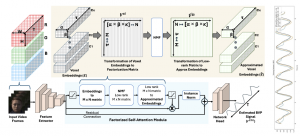
FactorizePhys: Matrix Factorization for Multidimensional Attention in Remote Physiological Sensing
Presented at NeurIPS 2024 & In press (Advances in Neural Information Processing Systems 37; NeurIPS 2024) Remote photoplethysmography (rPPG) enables non-invasive extraction of blood volume pulse signals through imaging, transforming spatial-temporal data into time series signals. Advances in end-to-end rPPG approaches have focused on this transformation where attention mechanisms are crucial for feature extraction. However, existing methods compute attention disjointly across spatial, temporal, and channel dimensions. Here, we propose the Factorized Self-Attention Module (FSAM), which jointly computes multidimensional attention from ...
Read More
Read More

iBVPNet and Toolkit for iBVP Dataset (2024)
Remote photo-plethysmography (rPPG) has emerged as a non-intrusive and promising physiological sensing capability in human–computer interface (HCI) research, gradually extending its applications in health-monitoring and clinical care contexts. With advanced machine learning models, recent datasets collected in real-world conditions have gradually enhanced the performance of rPPG methods in recovering heart-rate and heart-rate-variability metrics. However, the signal quality of reference ground-truth PPG data in existing datasets is by and large neglected, while poor-quality references negatively influence models. Here, this work introduces ...
Read More
Read More

PhysioKit: Open-Source, Low-Cost Physiological Computing Toolkit
The proliferation of physiological sensors opens new opportunities to explore interactions, conduct experiments and evaluate the user experience with continuous monitoring of bodily functions. Commercial devices, however, can be costly or limit access to raw waveform data, while low-cost sensors are efforts-intensive to setup. To address these challenges, we introduce PhysioKit, an open-source, low-cost physiological computing toolkit. PhysioKit provides a one-stop pipeline consisting of (i) a sensing and data acquisition layer that can be configured in a modular manner per research needs, and ...
Read More
Read More
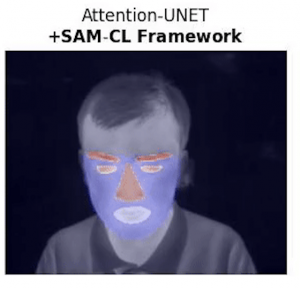
SAM-CL for Reliable segmentation of thermal facial images in unconstrained settings (2022)
Segmentation of thermal facial images is a challenging task. This is because facial features often lack salience due to high-dynamic thermal range scenes and occlusion issues. Limited availability of datasets from unconstrained settings further limits the use of the state-of-the-art segmentation networks, loss functions and learning strategies which have been built and validated for RGB images. To address the challenge, we propose Self-Adversarial Multi-scale Contrastive Learning (SAM-CL) framework as a new training strategy for thermal image segmentation. SAM-CL framework consists ...
Read More
Read More
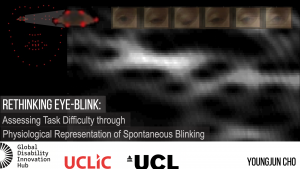
Rethinking Eye-blink Toolkit @CHI2021
Source codes are available at https://github.com/deepneuroscience/Rethinking-Eye-blink. Rethinking Eye-blink: Assessing Task Difficulty through Physiological Representation of Spontaneous Blinking Abstract:
Continuous assessment of task difficulty and mental workload is essential in improving the usability and accessibility of interactive systems. Eye tracking data has often been investigated to achieve this ability, with reports on the limited role of standard blink metrics. Here, we propose a new approach to the analysis of eye-blink responses for automated estimation of task difficulty. The core module is a ...
Read More
Continuous assessment of task difficulty and mental workload is essential in improving the usability and accessibility of interactive systems. Eye tracking data has often been investigated to achieve this ability, with reports on the limited role of standard blink metrics. Here, we propose a new approach to the analysis of eye-blink responses for automated estimation of task difficulty. The core module is a ...
Read More
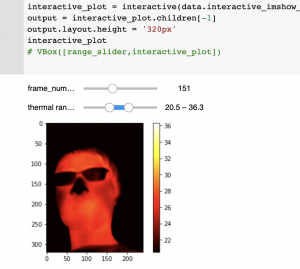
TIPA Opensource Project: Thermal Imaging-based Physiological and Affective computing toolkit
Mobile thermal imaging has created a new pathway to physiological measurements and affect recognition [1]. It enables contactless, simultaneous measurements of multiple vital signs and affective states. This can benefit healthcare, fitness sectors and specific user groups; for example, people with chronic pain who tend to reduce the number of clothes and/or devices that touch their body. Furthermore, a series of recent studies have demonstrated state-of-the-art performance with the use of small, light-weight, and low-cost sensing devices, which makes it ...
Read More
Read More
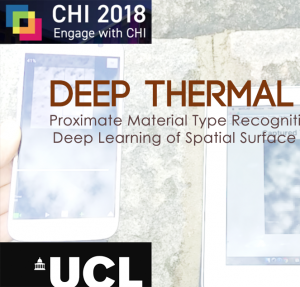
Deep Thermal Imaging Toolkit @CHI2018
Full source codes are available at https://github.com/deepneuroscience/DeepThermalImaging 1. Requirement Matlab (version>2012) MatConvNet (https://github.com/vlfeat/matconvnet): Deep CNN Framework for Matlab users. 2. Quick Summary DEEP THERMAL IMAGING - Main Libraries Void deep_thermal_imaging_training_and_testing(kfold, numberofclass, filename, directory, isoutdoor) Trains and Tests on the given dataset. Input variables:
-
- kfold (the number of k for k-fold cross validation)
-
- numberofclass (the number of class (material types))
-
- filename (the file name of your ...
Read More
- filename (the file name of your ...
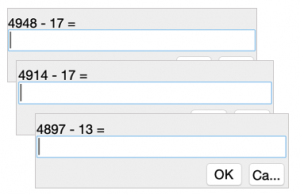
Matlab source codes: Stress Induction Tasks for “DeepBreath” @ACII2017
Source code for "DeepBreath Project" Description: We propose DeepBreath, a deep learning model which automatically recognises people's psychological stress level (mental overload) from their breathing patterns. Using a low cost thermal camera, we track a person's breathing patterns as temperature changes around his/her nostril. The paper's technical contribution is threefold. First of all, instead of creating hand-crafted features to capture aspects of the breathing patterns, we transform the uni-dimensional breathing signals into two dimensional respiration variability spectrogram (RVS) sequences. The ...
Read More
Read More
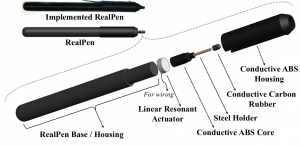
3D modelling files for RealPen @UIST 2016
Description: We present RealPen, an augmented stylus for capacitive tablet screens that recreates the physical sensation of writing on paper with a pencil, ball-point pen or marker pen. The aim is to create a more engaging experience when writing on touch surfaces, such as screens of tablet computers. This is achieved by regenerating the friction induced oscillation and sound of a real writing tool in contact with paper. To generate realistic tactile feedback, our algorithm analyzes the frequency spectrum of ...
Read More
Read More